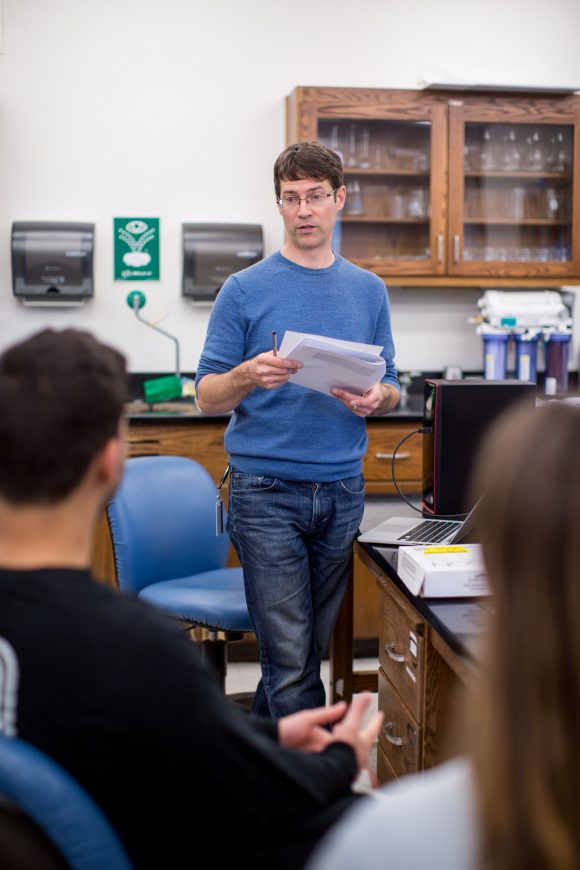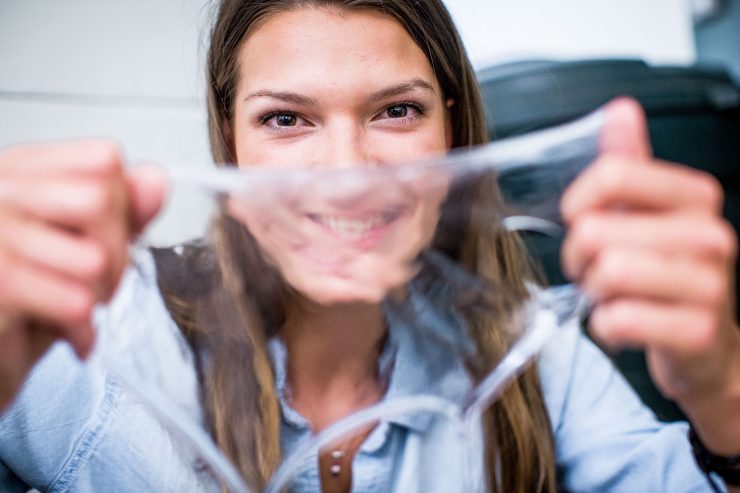The first time she saw one, Lauren Friend ’19 was repelled. “Maybe even disgusted,” she says. But over time, she has developed a healthy respect for her research subject, the humble hagfish, which despite its slimy appearance and scavenging nature wiggles its way into the hearts of researchers by steering them toward scientific breakthroughs.
“You have to appreciate what they can teach us,” the biochemistry major says.
Friend and her Chapman University student colleagues in the marine research lab of Professor Douglas Fudge, Ph.D., have dived deeply into the bottom-dwelling world of this intriguing creature. Behold the hagfish: once mistaken for a worm, with a skull but no vertebrae, lacking sight or a jaw but with the ability to produce a jaw-dropping amount of slime as a defense against predators.

Fudge has been hooked ever since he was a grad student. He considered focusing his research on squid, “but in the end, hagfish slime was something I couldn’t resist,” he says.
That slime is never far from the lives of the student researchers who frequent the stuffy closet-sized space that is the home of the hagfish at Chapman. On a recent Tuesday, Friend descends to the basement of Hashinger Science Center and lifts the lid from a circular tank.
“We have to be careful,” she says. “They’re escape artists.”
Using a net, she rouses several hagfish from their PVC-pipe lair in this DIY marine environment. After some deft coaxing and a transfer to a plastic bucket, she holds a single coiled specimen in the palm of her hand. Moments later, she returns the hagfish to the tank and reaches back into the bucket, then extends her fingers to reveal a transparent, mucousy, gelatinous goo.
It’s slime time.
As she holds up the pliable substance, silky strands elucidate why hagfish slime has researchers so excited. Thousands of super-strong threads – each more than 100 times thinner than a human hair – weave throughout the goo. If those strands can be replicated and mass-produced, they might provide an alternative to petroleum-based fibers like nylon and Kevlar.
“These are billion-dollar industries,” says Fudge, who adds that three industrial collaborators are in various stages of funding the team’s research.
Insights from the slime might also lead to advances in firefighting, anti-shark sprays, suspension gels for drugs – the possibilities seem limitless.
Ramteen Rafii ’18 and Dylan Blumberg ’18 are investigating just how the hagfish produces all that slime. In the controlled conditions of the lab, Rafii and Blumberg collect and then release a pre-slime substance called exudate, produced by glands on the hagfish. When it hits seawater, just a teaspoonful of the exudate almost instantly swells to create a supersized paste that clogs the gills of potential predators.
“We can hypothesize how the skeins (of the slime) unravel, but we don’t know just how they entrap the water,” Rafii says.
Their research might provide insights into clotting, and it could have food-science applications that lead to better storage gels.
“Understanding these mechanisms could reveal a lot,” Blumberg says.
The research of Sara Siwiecki ’18 is also slime-related. She’s breaking down its components to better understand the mix of thread skeins and mucous cells. Imaging with an atomic-force microscope helps her investigate how positively and negatively charged ions and proteins interact.
“There are not many scientific papers except from this lab, which allows us to be super creative as we try to solve problems,” Siwiecki says.
Even Siwiecki’s family members are pitching in on the problem-solving. When they learned that the student researchers had named only one of their 94 hagfish, Siwiecki’s family took up the challenge over spring break.
“My family came up with 93 names in like 20 minutes,” Siwiecki says. “This was at an engagement party. They asked how the hagfish are doing, and that led really fast to, ‘Oh, let’s name them all.’”
It seems that like slime in seawater, the hagfish legend is a growth industry.
Wiggle Room

One of the research projects in Professor Douglas Fudge’s marine lab looks at how hagfish can squirm into impossibly tight places. In the basement of Hashinger Science Center, students know the feeling. They have to squeeze into a pretty snug space themselves.
That will change when the new Center for Science and Technology opens in fall 2018. The 140,000-square-foot building’s design features a marine lab with more than twice the current capacity for researching hagfish. Fudge and his colleagues in the Schmid College of Science and Technology will also have room to add more equipment such as sophisticated microscopes and high-speed cameras, which are integral to the hagfish research.
Student researchers say they can’t wait to stretch out in the new facilities once the largest building project in Chapman’s history is completed.
“There will be so much more room and so many more opportunities,” says Stacey Zuppa ’18, a biology major and hagfish researcher. “We’ll be able to bring in a second tank and another species of hagfish. I’m excited about the possibilities.”
Display photo at top/ Biochemistry major Lauren Friend ’19 displays hagfish slime, which stretches to reveal its silky fibers. Photo by Nathan Worden ’13 (MBA ’15)





Add comment